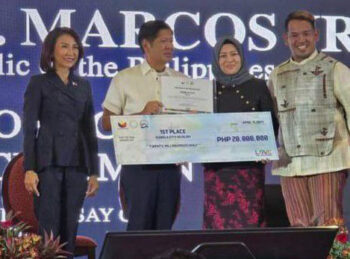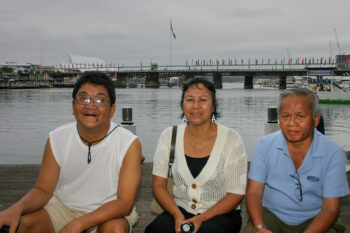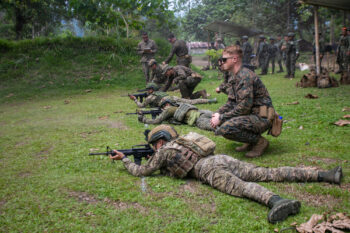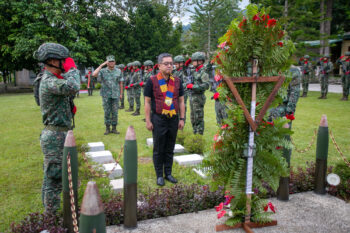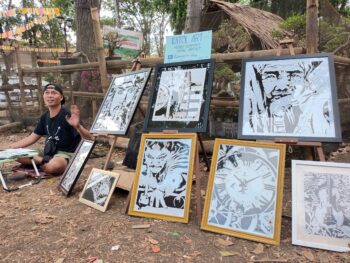DAVAO CITY (MindaNews/13 June) — The University Community Engagement and Advocacy Council (UCEAC) of the Ateneo de Davao University (ADDU) hosted a multistakeholder Pakighinabi (conversation) with the National Democratic Front of the Philippines (NDFP) on June 8, 2016, one of the first to be held after the encouraging statements and gestures of President-elect Rodrigo Duterte on the resumption of the peace talks. The Pakighinabi bannered the theme “When Blue meets Red.”
The lead discussant was Fidel Agcaoili, spokesperson of the NDFP Negotiating Panel, and Chairperson of the NDFP Human Rights Committee. The thoughts and questions of an illustrious panel of educators, political activists, peace advocates, an incoming legislator, and women and indigenous leaders, as well as those that came from a discerning audience during the plenary made the conversation colorful, layered and nuanced.
The peace talks between the Philippine Government (GPH) and the NDFP began in 1986, all of 30 years ago. In a manner of speaking, blue involvement—ADDU, that is—in red matters could also be said to be 30 years old in that in 1986 one of the first public discussions about the GPH-NDFP peace talks also took place in ADDU.
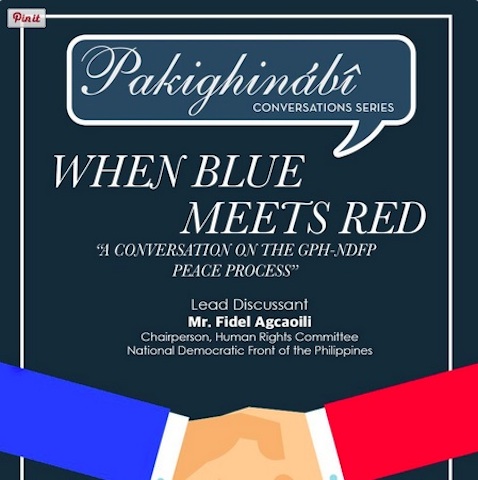 This column is inspired by the synthesis that I delivered for the June 8 Pakighinabi. Conversation panelist Timuway Jimid Mansayagan of Lumad Mindanao Foundation, who quipped “pwede pala mag-meet ang blue and red” provided the inspiration to use basic color theory—particularly the color wheel, context, harmony and mode—in capturing and organizing the Pakighinabi highlights.
This column is inspired by the synthesis that I delivered for the June 8 Pakighinabi. Conversation panelist Timuway Jimid Mansayagan of Lumad Mindanao Foundation, who quipped “pwede pala mag-meet ang blue and red” provided the inspiration to use basic color theory—particularly the color wheel, context, harmony and mode—in capturing and organizing the Pakighinabi highlights.
Color Wheel
Many of us are familiar with the color wheel and the concept of primary colors, which traditionally refers to the colors red, blue and yellow. But a more modern version of primary colors is one of red, blue and green. Since the color blue has long been associated with Ateneo, and the same could be said of the color red and revolutionary forces, applying the concept of primary colors in the theme of this Pakighinabi raises the question, whether yellow or green, who is the third party?
Ka Fidel talked about the countries that served as facilitators in the peace talks between the Philippine Government and the NDFP in the past, the governments of Belgium, the Netherlands, and of late the Royal Norwegian Government. The NDFP not only recognized the importance of a government serving as third party facilitator, but also with the planned return of Jose Maria Sison, the support of the governments of the countries that he would have to go through on his way home becomes very necessary to prevent security risks.
In the Pakighinabi, broadening civil society participation in the peace talks also came out as a call during the plenary, thus civil society could be the third party in the primary colors for peace. While the NDFP’s response to the call was an unmistakable “yes!” it also raised the question “how do we make CSO (civil society organizations) involvement in the peace process effective?,” particularly in light of perceived problematic experiences with CSOs in the past.
With Timuway Jimid saying “isama ninyo kami sa pag-uusap,” Indigenous Peoples’ involvement in the peace talks could also be viewed as an alternative version of a third party engagement. Lumad communities in the countryside have been hosting (or in another formulation, have been hostaged by) revolutionary forces for the past 47 years.
The issue of who constitutes the third party aside, it clearly cannot be a case of only two parties being involved in a peace process. The primary colors are the bases for the secondary and tertiary colors; thus the primary colors are the foundations of the vibrancy of the color wheel—and there clearly need to be three.
Color Context
Color context refers to how colors behave in relation to other colors. Color intensity and viewer perceptions can be affected when say red is set against a black background, compared to when it is juxtaposed against a white and even yellow background.
Ka Fidel’s narration of the history of the Communist Party in the Philippines—from the founding in 1930 to the 1968 reestablishment—put the red of the revolutionary movement against the red, white and blue of US colonial and neo-colonial forces and how those strove to thwart the revolution, as well as against the blue of militarist reactions against the peace process.
The latter’s interventions against peace talks with the NDFP included the coup d’état of the Reform the Armed Forces Movement (RAM) against the administration of Pres. Cory Aquino to allegedly oust the ‘leftists’ from her government, and the 1990 occupation of two military camp in Mindanao by renegade Col. Alexander Noble which prevented later efforts of Pres. Aquino to revive the peace talks.
In the run-up to the May 2016 elections, videos circulated in social media of alleged military officials vowing to oppose then candidate Duterte in fear of his alleged long-standing ties with communists. Against this backdrop of historical opposition from foreign powers and militarist forces, the peace talks with the NDFP took on a more intense quality.
Another example of color context was Fr. Bert Alejo, SJ’s reference to learnings and observations from the Bangsamoro peace process as a backdrop for examining the GPH-NDFP peace process. For the Moro Islamic Liberation Front (MILF), political identity came first in the negotiations rather than socio-economic reforms; but for the NDFP comprehensive socio-economic reforms will have to be addressed before political and constitutional change. Fr. Christopher Ablon, IFI, who represented the Philippine Ecumenical Peace Platform (PEPP) in the Pakighinabi, said that a key lesson in the NDFP process is the primacy of the principal — referring to the political will of the President.
Against the backdrop of the Bangsamoro experience, unsuccessful coordination of the executive with the judiciary in 2008 led to the unfavorable ruling against the Memorandum of Agreement on Ancestral Doman (MOA-AD). Similarly, executive will when unsupported by the legislative could deny peace efforts the necessary legal infrastructure, as exemplified by Congressional action (or more accurately non-action) on the Bangsamoro Basic Law bill.
Against the reality that little has progressed in the GPH-NDFP peace talks in the immediate past six years during the administration of President Noynoy Aquino, there is indeed cause for excitement about the upcoming informal talks in mid-June.
Color Harmony
Color schemes include the analogous scheme, complementary, split-complementary, triadic and even one called based on nature.
The analogous scheme refers to colors that are side by side in the color wheel, such as blue, blue-violet and violet. Fr. Joel Tabora, SJ, who studied Marxism extensively, provided observations about Christianity and revolutionary forces that highlighted not so much their differences but the ways that they are aligned. For instance, he remarked about Christianity’s strong resemblance to Marx’s philosophy about species-being, citing for example Pope Francis’s call for real action to transform the world, and Marx’s Eleven Theses on Feuerbach (“Philosophers have hitherto only interpreted the world in various ways; the point is to change it”). Fr. Tabora further said social justice was a tenet shared by the GPH and the NDFP. The Philippine Constitution has strong provisions about social justice although as Fr. Tabora pointed out it has often been interpreted in favor of human alienation. He argued that “peace is achieved not by giving up social justice” and that its triumph is possible under a government that is passionate for the poor.
It would be easy to conclude that Fr. Romeo Intengan, SJ’s comments on experiences of the absolute rule of communist parties and intolerance for independent civil society and labor unions around the world were mainly to show opposition between democratic socialism against national democracy, between which traditionally there have been political friction. However, it is worth noting that Fr. Intengan did say that his contrasting of the beliefs of the Abrahamic religions (Christianity, Islam and Judaism) with the practices of parties subscribing to Marxism-Leninism came “from faith, not from spite” and that he wanted to be clarified about the directions of the Communist Party of the Philippines (CPP).
Ka Fidel responded that the reforms that are being discussed in the peace talks are not communist demands but rather bourgeois democratic reforms intended to improve the lives of people. The exchange brought to mind the nature of the complementary color scheme, one of the more vibrant color harmonies: it is composed of colors that are opposite each other. After all, color harmony is about dynamic equilibrium rather than dull sameness.
The notion of color harmony based on nature came to mind when the discussants and other participants to the Pakighinabi raised a variety of issues: federalism, the K-12 and the educational system, the situation of Mindanao indigenous peoples, the Enhanced Defense Cooperation Agreement (EDCA) and the Visiting Forces Agreement (VFA) with the US, and the inclusion by the US Government of the CPP and NPA in its list of foreign terrorist organizations. The terrorist tag had been noted by Fr. Ablon as a key challenge to the GPH-NDFP peace talks. Ka Fidel noted this profusion of colorful issues, that they could be among those that would be tackled in the course of the peace talks, and that efforts would have to be exerted to determine what is cutting-edge. Like in the natural world where diversity is the basis of stability, hopefully the plethora of issues would ground and stabilize the peace talks rather than burden and disrupt it.
Color Mode
Color mode refers to the change in a hue when another color is added to it. Tints result when white is added to a color, shades when black is put in, and tones when gray is incorporated.
If an issue could be taken as a color, there were two specific issues that were tackled in the Pakighinabi from which tones, shades and tints could be derived. These were the Comprehensive Agreement on Respect for Human Rights and International Humanitarian Law (CARHRIHL), and the Lumad.
The focus on CAHRIHL during the Pakighinabi could not be helped, after all it was one of the four substantive issues in the peace talks as mentioned by incoming Anakpawis party list Representative Ariel Casilao, and the first major agreement signed by the GPH and NDFP. The fact that no joint investigation occurred on the 6,397 cases of CARHRIHL violations filed with the Joint Monitoring Committee was definitely a shade.
A bright spot, or tint, to CARHRIHL was its use by women in conflict-affected areas to assert their rights as reported by panelist Bai Ali Indayla of Gabriela Women’s Party. And if the offer mentioned by panelist Dr. Gail Ilagan for the local Bantay Bayanihan to serve as the civilian oversight of the NPA units in Davao City could not be taken as a tint, at the very least let it be a tone. Bantay Bayanihan is a civil society-led initiative on providing oversight to the AFP (Armed Forces of the Philippines), particularly the implementation of the Internal Peace and Security Plan (IPSP) Bayanihan.
There were definitely shades in the Lumad narratives raised during the Pakighinabi. Timuway Jimid mentioned that many Lumad were victims of Martial Law, counter-insurgency and extractive industries like mining, and that it is unfortunate that they were lumped under “other indigenous peoples” in item 10 of the NDFP 12-point program.
But what I could not immediately decipher in the Pakighinabi was the loud laughter that punctuated the remarks of Timuway Jimid such as when he said that the Lumad were “non-existing,” and reiterated the Lumad assertion that they “are the owners of the house, bisita lang kayo.”
I would like to think that the loud laughter during the Pakighinabi was not a shade—that is, that the audience found the stories humorous, or approved of the suffering of the Lumad — but more of a tone, the gray that is the embarrassed laughter of people who felt uncomfortable with the situation of the Lumad and did not know how to express their discomfort. Or perhaps it could have even been a tint in that it was the laughter of people who understood the irony in Timuway Jimid’s remarks, and an expression of their support for the critique articulated by the ironic statements. Because regardless of where one stood with respect to the GPH-NDFP peace talks, there is nothing humorous about the situation of the Lumad.
Perhaps another tint in the Lumad hue was Ka Fidel’s information that the NDFP has an IP organization among its affiliates. Hopefully, this IP organization would lead continuing conversations that would get past the controversial view imputed to an NDFP leader that IPs are but a transitory stage in development.
Closing
I had hoped to close the synthesis of the June 8 Pakighinabi by referring to Timuway Jimid’s statement that left wing and right wing did not matter to the Lumad because a bird could not fly without them. But that would be a case of endorsing a binary after I had argued for multiple colors. Then I thought of using the rainbow as a device, but that might not sit well with the LGBTQIA (lesbian, gay, bisexual, transgender, queer, intersex and asexual) community who held the first Davao city-wide Pride March last June 1. Perhaps the sapin-sapin, the Filipino rice cake, would be a better image because it is local and has different colors. But the sapin-sapin layers that sit on top of another somehow evoke relationships of power and division.
In the end, I would like to offer the image of the cathedral window jelly, a dessert that features colorful gelatin cubes interspersed and embedded in a creamy mold, and which is said to be uniquely Filipino. The creamy gelatin mold enables each colored jelly to come out, and serves as a binder that unites the different colors as one dish. Best of all, the cathedral window jelly could be shared and enjoyed by, and thus nourish and benefit many. This image and experience seem apropos for what the different stakeholders present in the June 8 Pakighinabi are seeking to achieve for the Philippines of the coming days through the GPH-NDFP peace process.
(MindaViews is the opinion section of MindaNews. Mags Z. Maglana is a Mindanawon who has worked in various capacities over the past 30 years for peace, good governance, sustainable development, and the promotion of human rights. Please email feedback to magszmaglana@gmail.com)

